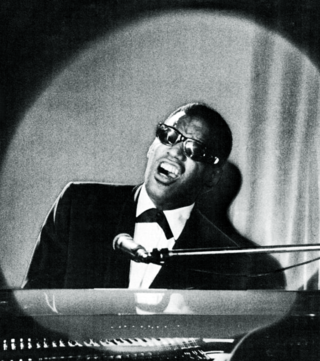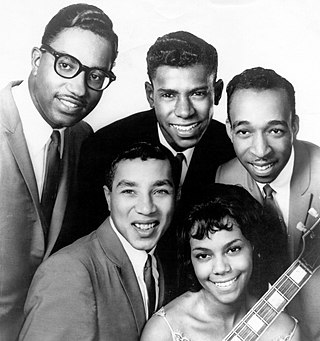Rock is a broad genre of popular music that originated as "rock and roll" in the United States in the late 1940s and early 1950s, developing into a range of different styles from the mid-1960s, particularly in the United States and the United Kingdom. It has its roots in 1940s and 1950s rock and roll, a style that drew directly from the blues and rhythm and blues genres of African-American music and from country music. Rock also drew strongly from genres such as electric blues and folk, and incorporated influences from jazz and other musical styles. For instrumentation, rock has centered on the electric guitar, usually as part of a rock group with electric bass guitar, drums, and one or more singers. Usually, rock is song-based music with a 4
4 time signature using a verse–chorus form, but the genre has become extremely diverse. Like pop music, lyrics often stress romantic love but also address a wide variety of other themes that are frequently social or political. Rock was the most popular genre of music in the U.S. and much of the Western world from the 1950s to the 2010s.
Glam rock is a style of rock music that developed in the United Kingdom in the early 1970s and was performed by male musicians who wore flamboyant and feminine clothing, makeup, and hairstyles, particularly platform shoes and glitter, and female musicians who wore masculine clothing. Glam artists drew on diverse sources across music and throwaway pop culture, ranging from bubblegum pop and 1950s rock and roll to cabaret, science fiction, and complex art rock. The flamboyant clothing and visual styles of performers were often camp or androgynous, and have been described as playing with other gender roles. Glitter rock was a more extreme version of glam rock.
Bubblegum is pop music in a catchy and upbeat style that is marketed for children and adolescents. The term also refers to a more specific rock and pop subgenre, originating in the United States in the late 1960s, that evolved from garage rock, novelty songs, and the Brill Building sound, and which was also defined by its target demographic of preteens and young teenagers. The Archies' 1969 hit "Sugar, Sugar" was a representative example that led to cartoon rock, a short-lived trend of Saturday-morning cartoon series that heavily featured pop rock songs in the bubblegum vein.

Soul music is a popular music genre that originated in the African American community throughout the United States in the late 1950s and early 1960s. It has its roots in African-American gospel music and rhythm and blues. Soul music became popular for dancing and listening, where U.S. record labels such as Motown, Atlantic and Stax were influential during the Civil Rights Movement. Soul also became popular around the world, directly influencing rock music and the music of Africa. It also had a resurgence in the mid-to late 1990s with the subgenre neo-soul, which added modern production elements and influence from hip-hop.

In popular music, a cover version, cover song, remake, revival, or simply cover is a new performance or recording by a musician other than the original performer or composer of the song. Originally, it referred to a version of a song released around the same time as the original in order to compete with it. Now, it refers to any subsequent version performed after the original.
Power pop is a subgenre of rock music and a form of pop rock based on the early music of bands such as the Who, the Beatles, the Beach Boys, and the Byrds. It typically incorporates melodic hooks, vocal harmonies, an energetic performance, and cheerful sounding music underpinned by a sense of yearning, longing, despair, or self-empowerment. The sound is primarily rooted in pop and rock traditions of the early-to-mid 1960s, although some artists have occasionally drawn from later styles such as punk, new wave, glam rock, pub rock, college rock, and neo-psychedelia.

Jazz fusion is a popular music genre that developed in the late 1960s when musicians combined jazz harmony and improvisation with rock music, funk, and rhythm and blues. Electric guitars, amplifiers, and keyboards that were popular in rock and roll started to be used by jazz musicians, particularly those who had grown up listening to rock and roll.
The music of Finland can be roughly divided into folk music, classical and contemporary art music, and contemporary popular music.
The music of Hawaii includes an array of traditional and popular styles, ranging from native Hawaiian folk music to modern rock and hip hop. Styles like slack-key guitar are well known worldwide, while Hawaiian-tinged music is a frequent part of Hollywood soundtracks. Hawaii also made a contribution to country music with the introduction of the steel guitar. In addition, the music which began to be played by Puerto Ricans in Hawaii in the early 1900s is called cachi cachi music, on the islands of Hawaii.

Popular music of the United States in the 1970s saw various forms of pop music dominating the charts. Often characterized as being shallow, 1970s pop took many forms and could be seen as a reaction against the high-energy and activist pop of the previous decade. It began with singer-songwriters like Carole King and Carly Simon topping the charts, while New York City saw a period of great innovation; hip hop, punk rock and salsa were invented in 1970s New York, which was also a center for electronic music, techno.
Popular music of the United Kingdom in the 1970s built upon the new forms of music developed from blues rock towards the end of the 1960s, including folk rock and psychedelic rock movements. Several important and influential subgenres were created in Britain in this period, by pursuing the limitations of rock music, including British folk rock and glam rock, a process that reached its apogee in the development of progressive rock and one of the most enduring subgenres in heavy metal music. Britain also began to be increasingly influenced by third world music, including Jamaican and Indian music, resulting in new music scenes and subgenres. In the middle years of the decade the influence of the pub rock and American punk rock movements led to the British intensification of punk, which swept away much of the existing landscape of popular music, replacing it with much more diverse new wave and post punk bands who mixed different forms of music and influences to dominate rock and pop music into the 1980s.

A tribute act, tribute band, tribute group or tribute artist is a music group, singer, or musician who specifically plays the music of a well-known music act. Tribute acts include individual performers who mimic the songs and style of an artist, such as Elvis impersonators covering the works of Elvis Presley or groups like The Iron Maidens, an all-female band that pays tribute to Iron Maiden.
Pinoy rock, or Filipino rock, is the brand of rock music produced in the Philippines or by Filipinos. It has become as diverse as the rock music genre itself, and bands adopting this style are now further classified under more specific genres or combinations of genres like alternative rock, post-grunge, ethnic, new wave, pop rock, punk rock, funk, reggae, heavy metal, ska, and recently, indie. Because these genres are generally considered to fall under the broad rock music category, Pinoy rock may be more specifically defined as rock music with Filipino cultural sensibilities.

Music history of the United States includes many styles of folk, popular and classical music. Some of the best-known genres of American music are rhythm and blues, jazz, rock and roll, rock, soul, hip hop, pop, and country. The history began with the Native Americans, the first people to populate North America.

American popular music is popular music produced in the United States of America and is a part of American pop culture. Distinctive styles of American popular music emerged early in the 19th century, and in the 20th century the American music industry developed a series of new forms of music, using elements of blues and other genres. These popular styles included country, R&B, jazz and rock. The 1960s and 1970s saw a number of important changes in American popular music, including the development of a number of new styles, such as heavy metal, punk, soul, and hip hop.
Popular music in Yugoslavia includes the pop and rock music of the former SFR Yugoslavia, including all their genres and subgenres. The scene included the constituent republics: SR Slovenia, SR Croatia, SR Bosnia and Herzegovina, SR Montenegro, SR Macedonia and SR Serbia and its subunits: SAP Vojvodina and SAP Kosovo. The pop and rock scene was a part of the general Music of Yugoslavia, which also included folk, classical music, jazz etc. Within Yugoslavia and internationally, the phrases ex-YU or ex-Yugoslav Pop and Rock both formally and informally generally to the SFRY period, though in some cases also to its successor the FR Yugoslavia including Serbia and Montenegro which existed until 2006.
A revivalist artist or revivalist band is a musical group, singer, or musician dedicated to reviving interest in a musical genre from an earlier era.

This article includes an overview of the major events and trends in popular music in the 1970s.

This article includes an overview of the events and trends in popular music in the 1960s.







